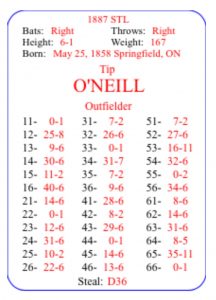He was known as ”Canada’s Babe Ruth” and the ”Woodstock Wonder.” Every year since 1984, the Canadian Baseball Hall of Fame gives out an award to a Canadian player “judged to have excelled in individual achievement and team contribution while adhering to the highest ideals of the game of baseball.” It’s called the Tip O’Neill Award.
Tip O’Neill played Major League baseball from 1883 to 1892 for a variety of teams. For most of his career, O’Neill played for the St. Louis Browns, before they became the Cardinals. O’Neill was a .326 lifetime hitter, who smacked 52 dead-ball era home runs. He was the American Association RBI champion in 1886, and he was the American Association batting champion in 1888. However, 1887 was, by far, his best season. That year, he became the second player to win the Triple Crown.
| Year | Tm | G | PA | AB | R | H | 2B | 3B | HR | RBI | SB | BB | SO | BA | OBP | SLG | OPS | OPS+ | TB | HBP |
|---|---|---|---|---|---|---|---|---|---|---|---|---|---|---|---|---|---|---|---|---|
| 1887 | STL | 124 | 572 | 517 | 167 | 225 | 52 | 19 | 14 | 123 | 30 | 50 | 20 | .435 | .490 | .691 | 1.180 | 213 | 357 | 5 |
In 1887, Tip O’Neill had an amazing season. Not only did O’Neill lead the league in the Triple Crown categories, he also led it in hits, runs, doubles, triples, OBP, SLG, OPS, OPS+, and total bases. Tip’s .435 batting average is second only to Hugh Duffy’s .440 mark in 1894. Originally, O’Neill’s average was recorded at .492 because walks were counted as hits, but it was adjusted by baseball historians. After plugging O’Neill’s statistics into Steve’s APBA Card Computer, it produced the card pictured at the top of this post. It’s a tremendous card that I project will produce a .451 average. Other than lacking first column 1s, this card is a monster. What I notice first is the 55-0. That’s something you don’t see often. Next on the “what the heck” list is the 35-7. Can you imagine rolling against an A&B pitcher, rolling a 35, and getting a single? I’d laugh out loud. I also enjoy the 13-9 and 36-9. You know you’ve got a tremendous card when spots need to be found to put your 8s and 9s. This card would do wonders anywhere in a lineup, but it’s an ideal leadoff card. With 14 chances to reach base with nobody on against an A/A&C/A&B pitcher, it’s got a 39% chance of starting your inning right. Against a D pitcher, it’s got a 53% chance of reaching base.
Like Paul Hines, Tip O’Neill is the only other eligible Triple Crown winner not in the Baseball Hall of Fame. Playing in the American Association (not the superior National League) and his short career hurts his candidacy. However, O’Neill was considered one of the best players of his time, and there have been strong arguments for his induction. Chief among them is the fact that Bill James’s Win Shares system projects O’Neill as the fourth best left fielder in history, behind Ted Williams, Barry Bond, and Shoeless Joe Jackson. I hope that the Early Baseball Committee (1871-1949) takes a serious look at Tip O’Neill in 2020.





I got roughly the same numbers when I created my 1887 season with Wizard for Windows, and for me O’Neill hit .457/.505/.717 with 60 doubles, 13 triples, 17 homers, 179 runs, 138 RBI, and 55 walks. The average is a little high but the card computers do a pretty good job of getting it close
That’s very interesting. It’s amazing how close the numbers are. I’d be interested to know more about your 1887 season replay. I’d bet others would as well. How did the Detroit Wolverines do? Who was in the championship series?
“With 14 chances to reach base with nobody on against an A/A&C/A&B pitcher, it’s got a 39% chance of starting your inning right. Against a D pitcher, it’s got a 53% chance of reaching base.”
And against a D pitcher with a (W) and a Fielding 3 defense, it has a 58% chance.
I put together a pre-1900 team that I play for fun, with an outfield of Duffy in center, O’Neil in left, and right field split between 1894 Sam Thompson and 1897 Willie Keeler. Good luck getting through those guys.
BTW – Everybody always talks about 1930 being the greatest year for hitting, but I would say 1894 is as good, if not better.